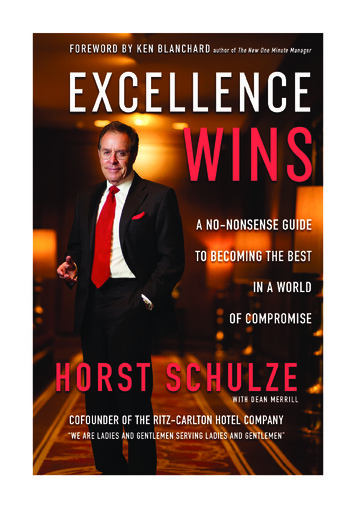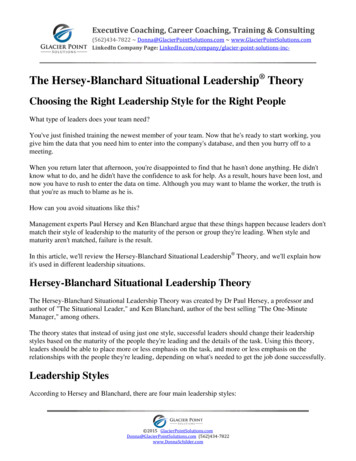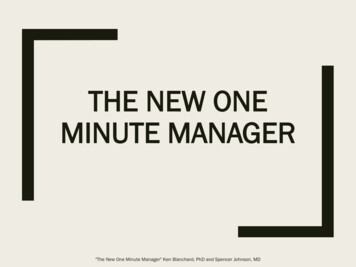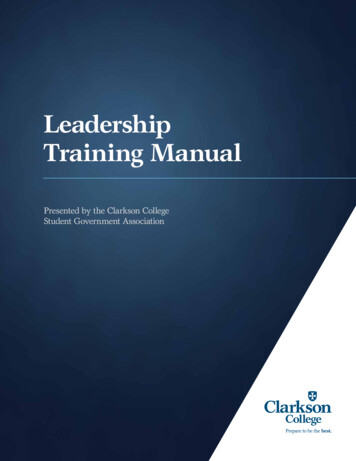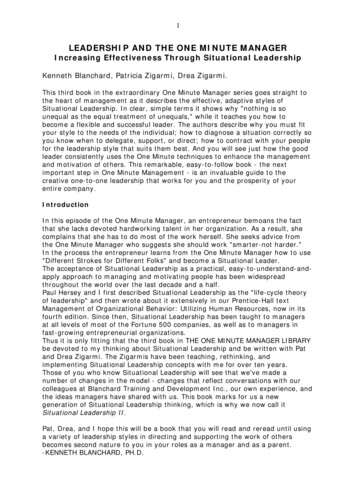
Transcription
1LEADERSHIP AND THE ONE MINUTE MANAGERIncreasing Effectiveness Through Situational LeadershipKenneth Blanchard, Patricia Zigarmi, Drea Zigarmi.This third book in the extraordinary One Minute Manager series goes straight tothe heart of management as it describes the effective, adaptive styles ofSituational Leadership. In clear, simple terms it shows why "nothing is sounequal as the equal treatment of unequals," while it teaches you how tobecome a flexible and successful leader. The authors describe why you must fityour style to the needs of the individual; how to diagnose a situation correctly soyou know when to delegate, support, or direct; how to contract with your peoplefor the leadership style that suits them best. And you will see just how the goodleader consistently uses the One Minute techniques to enhance the managementand motivation of others. This remarkable, easy-to-follow book - the nextimportant step in One Minute Management - is an invaluable guide to thecreative one-to-one leadership that works for you and the prosperity of yourentire company.IntroductionIn this episode of the One Minute Manager, an entrepreneur bemoans the factthat she lacks devoted hardworking talent in her organization. As a result, shecomplains that she has to do most of the work herself. She seeks advice fromthe One Minute Manager who suggests she should work "smarter-not harder."In the process the entrepreneur learns from the One Minute Manager how to use"Different Strokes for Different Folks" and become a Situational Leader.The acceptance of Situational Leadership as a practical, easy-to-understand-andapply approach to managing and motivating people has been widespreadthroughout the world over the last decade and a half.Paul Hersey and I first described Situational Leadership as the "life-cycle theoryof leadership" and then wrote about it extensively in our Prentice-Hall textManagement of Organizational Behavior: Utilizing Human Resources, now in itsfourth edition. Since then, Situational Leadership has been taught to managersat all levels of most of the Fortune 500 companies, as well as to managers infast-growing entrepreneurial organizations.Thus it is only fitting that the third book in THE ONE MINUTE MANAGER LIBRARYbe devoted to my thinking about Situational Leadership and be written with Patand Drea Zigarmi. The Zigarmis have been teaching, rethinking, andimplementing Situational Leadership concepts with me for over ten years.Those of you who know Situational Leadership will see that we've made anumber of changes in the model - changes that reflect conversations with ourcolleagues at Blanchard Training and Development Inc., our own experience, andthe ideas managers have shared with us. This book marks for us a newgeneration of Situational Leadership thinking, which is why we now call itSituational Leadership II.Pat, Drea, and I hope this will be a book that you will read and reread until usinga variety of leadership styles in directing and supporting the work of othersbecomes second nature to you in your roles as a manager and as a parent.-KENNETH BLANCHARD, PH.D.
2A Visit from an EntrepreneurThe One Minute Manager got a call one day from a woman who said she was an"entrepreneur." He was glad to hear from her because he knew that the countrywas in the midst of an entrepreneurial boom and that a large share of the growthin new businesses came from women.The entrepreneur explained that she was having a hard time finding people whowere willing to work as hard as she was."I seem to have to do everything. I feel like the Lone Ranger," said theentrepreneur."What you have to do," said the One Minute Manager, "is learn to delegate.""But my people are not ready," said the entrepreneur."Then you need to train them," said the One Minute Manager."But I don't have time," said the entrepreneur."If that's the case," grinned the One Minute Manager, "you do have a problem.Why don't you come over this afternoon and let's have a talk."Being SuccessfulThat afternoon when the entrepreneur arrived at the One Minute Manager's officeshe found him talking to his secretary at her desk."I appreciate your willingness to meet with me," said the entrepreneur as shejoined the One Minute Manager in his office."lt's my pleasure," said the One Minute Manager. "I’ve heard that you have beenvery successful in a number of ventures. What do you think it takes to besuccessful?""It's really quite easy," smiled the entrepreneur. "All you have to do is work halfa day. You can work either the first twelve hours or the second twelve hours."The One Minute Manager had a good laugh.Then he said, "While l think the amount of time and effort you put into work isimportant, I'm afraid too many people think there is a direct relationshipbetween amount of work and success - the more time you put in, the moresuccessful you will be.""I thought you would say that," said the entrepreneur. "In fact, l understand oneof your favorite quotes is: Don't Work Harder - Work Smarter"Absolutely," said the One Minute Manager. ((Before talking about some of mythoughts on working smarter, let me ask you one more question.""Fire away," said the entrepreneur."You call yourself an entrepreneur," said the One Minute Manager. "What doesthat mean to you?"The entrepreneur smiled and said, "A friend of mine described beautifully what itmeans to be an entrepreneur. He told me he once took his senior vice-presidentto the top of a hill that overlooked the city. It was a beautiful view."He said to his vice-president, "Do you see that ridge down there? Wouldn't thatbe a great place to build a house?""It sure would be", said his vice-president. "Can you imagine a pool over to theright? Wouldn't that be something?" continued my friend."Just tremendous," said the vice-president. "How about a tennis court to theleft?" said my friend."What a setting," said the vice-president.
3"Let me tell you one thing," said my friend. "If you continue to work as hard asyou have and accomplish all the goals we have set, I guarantee that someday someday all of that will be mine.""That's beautiful," said the One Minute Manager with a big smile on his face. "ButI think that story illustrates some of your problems with managing andmotivating others.""What do you mean?" asked the entrepreneur.Thinking Differently About Leadership"Let me explain it this way," said the One Minute Manager. "I would imagine yourorganization looks like a pyramid with you, as the CEO, at the top and all thehourly employees at the bottom. In between are several levels of management.""That's the way it's organized," said the entrepreneur. "Is there something wrongwith a pyramidal organization?""No," said the One Minute Manager. "There is nothing wrong with it as anorganizational model. The trouble comes when you think in a pyramid.""I don't think I follow you," said the entrepreneur."When you think in a pyramid," continued the One Minute Manager, "theassumption is that everyone works for the person above them on theorganizational ladder. As a result, managers are thought to be ‘responsible’ forplanning, organizing, and evaluating everything that happens in the organizationwhile their people are supposed to be responsive to the directives ofmanagement.' That's why people like you end up thinking managers do all thework.""How should it be?" asked the entrepreneur."I prefer to turn the pyramid upside down so that top managers are at thebottom," said the One Minute Manager. "When that happens there is a subtle,but powerful, twist in who is responsible and who should be responsive towhom.""In other words, you're saying managers should work for their people," said theentrepreneur, "and not the reverse.""Precisely," said the One Minute Manager. "If you think your people areresponsible and that your job is to be responsive, you really work hard to providethem with the resources and working conditions they need to accomplish thegoals you've agreed to. You realize your job is not to do all the work yourself orto sit back and wait to catch them doing something wrong,' but to roll up yoursleeves and help them win. If they win, you win.""But as I told you earlier," said the entrepreneur, "I don't have time to beresponsive to the needs of all my people.""You don't have to work closely with all your people," said the One MinuteManager, "only those who need help.""You mean you treat people differently?" wondered the entrepreneur."Absolutely," said the One Minute Manager. "There's a saying we use aroundhere that says it all: "Different Strokes For Different Folks"
4Different Strokes for Different Folks"If that’s true," wondered the entrepreneur, "how do you treat your peopledifferently?""Why don't you talk to some of them?" asked the One Minute Manager. "Theycan tell you about my various leadership styles.""Leadership styles?" echoed the entrepreneur."Your leadership style is the way you supervise or work with someone," said theOne Minute Manager. "It's how you behave, over time, when you're trying toinfluence the performance of others.""Is your leadership style the way you think you behave," asked the entrepreneur,"or the way others say you behave?""Let me explain it this way," said the One Minute Manager. "If you think you arean empathetic, people-oriented manager, but your people think you are a hardnosed, task-oriented person, whose perception of reality will they use - yours ortheir' own?""Obviously their own," said the entrepreneur. "Right," said the One MinuteManager. "Your perception of how you behave is interesting but it tells you onlyhow you intend to act. Unless it matches the perceptions of others it is not veryhelpful. That's why I want you to talk to some of my people. They'll give you thestraight scoop on my leadership style so you can see if I really treat peopledifferently.""Sounds good to me," said the entrepreneur."But I suppose you won't help me decide which I should talk to.""No," chuckled the One Minute Manager. "As you know, I seldom make decisionsfor my people." With that said, he leaned over and spoke into the officeintercom. His secretary, Mrs. Johnson, came in moments later and handed theentrepreneur a list of six names."Here's a list of the people who report to me," said the' One Minute Manager."Pick any name. Talk to any of them.""Let me start with Larry McKenzie," said the entrepreneur as she looked at thelist. "Then he can take me around to the others I want to see." I’m sure he will,"said the One Minute Manager, smiling."I’ll get directions to his office from Mrs. Johnson," said the entrepreneur. "Seeyou later.""I’ll look forward to it," said the One Minute Manager.Perceptions of OthersThe entrepreneur was feeling good, as she headed toward McKenzie's office. Shewas glad she had decided to come to see the One Minute Manager. "I have afeeling I will learn some useful things here," she thought to herself.When she got to McKenzie's office, she found a relaxed-looking man in his earlythirties. He was the director of training and human resource development for thecompany.After they exchanged greetings, McKenzie got right to the point. "I understandyou've been visiting with the boss. What can I do for you?""I’m interested in finding out how the One Minute Manager works with you," saidthe entrepreneur. "Would you call him a participative manager? I've beenreading a lot about participative management."
5"He's far from participative with me," said McKenzie. "In fact, he is very directivewith me. Training and human resource development is his baby. So my job isessentially to implement his ideas.""Does he assign you tasks and then just leave you alone?" wondered theentrepreneur."No," said McKenzie. "He assigns me tasks and then works very closely with me.Right now I am an extension of the One Minute Manager in this area.""Don't you resent that?" asked the entrepreneur. "It sounds pretty autocratic tome.""Not at all," said McKenzie. "I was in personnel - in wage and salaryadministration to be exact - before I got this position three months ago. Ijumped at the opportunity to move into training and human resourcedevelopment because working with the One Minute Manager would give me achance to learn the HRD area from the ground up. He is considered a real prowhen it comes to managing and training people. So when he works with me, hehelps me plan what he wants me to do. He's very clear about how he wants meto do it; and I always know where I stand and what he thinks about myperformance because of the frequent meetings we have.""Do you think he will ever let you make any decisions on your own?" asked theentrepreneur."Yes," said McKenzie, "as I learn the ropes. But you know, it's hard to make gooddecisions when I don't know a lot about the job yet. Right now I'm glad that theOne Minute Manager wants to be involved. I'm excited about my job and as Igain experience, I'm sure I'll take more responsibility.""Does the One Minute Manager treat everyone who reports to him the way hemanages you?" asked the entrepreneur."No," said McKenzie. "Let me take you next door and have you meet CindyMurrow, our director of finance. The One Minute Manager treats her verydifferently."With that McKenzie got up and started toward the door. The entrepreneurfollowed closely behind. When they got to Murrow's office, the entrepreneur meta thoughtful-looking woman in her middle forties. After thanking McKenzie for histime, the entrepreneur sat down with Murrow."McKenzie said that the One Minute Manager supervises you differently than hedoes him," began the entrepreneur. "Is that true?""Absolutely," said Murrow. "We operate as colleagues in the financial area. TheOne Minute Manager never tells me what to do but together we arrive at thedirection we want to take.""Sounds like he is very participative with you," said the entrepreneur."Very much so," said Murrow. "I get a lot of support, encouragement, and praisefrom the One Minute Manager. What I find him doing is listening to me anddrawing me out. He also shares lots of information about the whole companywith me so I can make better decisions about what to do in finance. It's a perfectworking relationship for me. I've been working in finance for over fifteen years soit feels good to be treated as a competent, contributing member of a team. I'veworked for some other people who certainly didn't make me feel like that.""From talking to you," said the entrepreneur, "I’m beginning to believe that theOne Minute Manager is either autocratic or democratic. With McKenzie he is verydirective and authoritarian, and with you he's very supportive and participative.""Don't draw any conclusions about these being his only two styles," said Murrow,"until you talk to John DaLapa, our director of operations."
6"You mean the One Minute Manager treats DaLapa differently than he does eitheryou or McKenzie?" asked the entrepreneur."He sure does," said Murrow. "John is down the hall. Why don't I take you downto chat with him.""That would be helpful," said the entrepreneur.When Murrow and the entrepreneur reached DaLapa's office, he was talking withthe One Minute Manager."I’d better get out of here," laughed the One Minute Manager, "or you will think Iam prejudicing your sample.""He doesn't scare me," smiled DaLapa as he shook hands with the entrepreneur.He nodded at Murrow and the One Minute Manager. "I’ll tell her the real truth."The entrepreneur admired the fun, supportive atmosphere she found in thecompany. Everyone seemed to enjoy and respect one another.When Murrow and the One Minute Manager left, DaLapa invited the entrepreneurto sit down. "Well, what can I do for you?" he asked. "Murrow says that the OneMinute Manager supervises you differently from the way he manages eitherMcKenzie or her. Is that true?""Well, I don't know about that," said DaLapa. "It’s not easy for me to describe hisstyle.""What do you mean?" asked the entrepreneur."Well, my job is relatively complicated," DaLapa said. "I’m ultimately responsiblefor all of production. That means I supervise and control each part of theoperation. I'm also responsible for inspection and quality control, as well as forhiring and firing. What I find is that the One Minute Manager uses one style withme on certain parts of my job and another style with me on other parts. Forexample, on the operations end of my job he literally leaves me alone, but ittook him a while before he would do that. The One Minute Manager built thiscompany from the ground up. Because he knows the technical side of thebusiness as well as I do, he's come to respect and trust my judgment ontechnical matters. Now he just says, "Keep me informed but that's your area you run with the ball. You're the technical expert around here.'""You mean he doesn't discuss things with you or tell you what to do or tell youhow to solve a particular problem?" questioned the entrepreneur."No," said DaLapa. "Not as far as the technical part of my job goes. But his styleis completely different when it comes to the people part of my job. He insiststhat I consult with him before I implement any new personnel programs orpolicies. He wants to know exactly what I intend to do.""Does he tell you what to do in those areas?" asked the entrepreneur."He always tells me his opinion," said DaLapa, ((if that's what you mean. But heusually asks mine, too.""If there is a difference in your opinions and you come to agreement, whodecides?" wondered the entrepreneur."The One Minute Manager decides.""Is it disconcerting when he treats you one way sometimes and another way atother times?" asked the entrepreneur."Not at all," said DaLapa. "I just love the freedom he gives me on the operationspart of my job. After all, I started as a technician here and worked my way upthe ladder to my present position. Over the twenty years I've been here, I havealways kept on top of our technology.""Wouldn't you like to be treated in the same ay in the personnel area?" asked theentrepreneur.
7"Not really," said DaLapa. "With people I'm sometimes like a bull in a china shop.In fact, some people claim I knock down the door and then ask if I can come in.So I'm not always confident about my interpersonal skills. That's why I welcomethe One Minute Manager's suggestions.""It sounds like the One Minute Manager is an eclectic manager," said theentrepreneur, "one who is able to choose from a variety of styles.""I wouldn't say that to him," said DaLapa."Why?" wondered the entrepreneur."Because he defines an eclectic as someone who has both feet planted inmidair," laughed DaLapa."Well, what kind of leader would you call him?" asked the entrepreneur."A situational leader," said DaLapa. "He changes his style depending on theperson he is working with and on the situation."Leadership Style Flexibility"A situational leader . " That phrase kept going through the entrepreneur'smind as she headed back to the One Minute Manager's office. When she arrived,Mrs. Johnson ushered her in to see the One Minute Manager."Well, how did I do?" asked the One Minute Manager."Just fine," said the entrepreneur. "Your philosophy of Different Strokes forDifferent Folks is alive and well. And what's more, your folks don't seem to mindbeing treated differently. How can I become a situational leader?'"You need to learn three skills," said the One Minute Manager."I knew you would have it down to some simple formula," the entrepreneurteased."I’m not sure it's so simple," chuckled the One Minute Manager, "but there arethree skills involved. You have to learn to use a variety of leadership stylesflexibly. You have to learn how to diagnose the needs of the people yousupervise. And you have to learn how to come to some agreements with them,to contract with them for the leadership style they need from you. In otherwords, the three skills are: flexibility, diagnosis, and contracting.""Sounds fascinating," said the entrepreneur."Where do I start?""We usually start by teaching people about flexibility," said the One MinuteManager. "That's why I sent you to talk to some of my people - to find out aboutthe different leadership styles I use with them.""I thought I had a handle on your styles until I talked to DaLapa," said theentrepreneur."What do you mean?" asked the One Minute Manager."I thought you were either autocratic or democratic," said the entrepreneur, "butthat didn’t fit with DaLapa.""That always surprises people," said the One Minute Manager. "For a long timepeople thought there were only two leadership styles - autocratic anddemocratic. In fact, people used to shout at each other from these two extremes,insisting that one style was better than the other. Democratic managers wereaccused of being too soft and easy, while their autocratic counterparts wereoften called too tough and domineering. But I have always felt that managerswho restricted themselves to either extreme were only "half a manager.""What makes someone a whole manager?" asked the entrepreneur."A whole manager is flexible and is able to use four different leadership styles,"said the One Minute Manager as he showed the entrepreneur a sheet of paper.
8THE FOUR BASIC LEADERSHIP STYLES ARE:Style 1: DIRECTINGTHE LEADER PROVIDES SPECIFIC INSTRUCTIONS AND CLOSELY SUPERVISES TASKACCOMPLISHMENT.Style 2: COACHINGTHE LEADER CONTINUES TO DIRECT AND CLOSELY SUPERVISE TASK ACCOMPLISHMENT, BUTALSO EXPLAINS DECISIONS, SOLICITS SUGGESTIONS, AND SUPPORTS PROGRESS.Style 3: SUPPORTINGTHE LEADER FACILITATES AND SUPPORTS SUBORDINATES' EFFORTS TOWARD TASKACCOMPLISHMENT AND SHARES RESPONSIBILITY FOR DECISION-MAKING WITH THEM.Style 4: DELEGATINGTHE LEADER TURNS OVER RESPONSIBILITY FOR DECISIONNMAKING AND PROBLEM-SOLVING TOSUBORDINATES.The Four Basic Leadership StylesAs the entrepreneur studied the information on the sheet of paper, the OneMinute Manager began to explain it."These four styles consist of different combinations of two basic leadershipbehaviors that a manager can use when trying to influence someone else:Directive Behavior and Supportive Behavior. Three words can be used to defineDirective Behavior: STRUCTURE, CONTROL, and SUPERVISE. Different words areused to describe Supportive Behavior: PRAISE, LISTEN, and FACILITATE.""Directive behavior seems to be related to autocratic leadership," said theentrepreneur.""Precisely," said the One Minute Manager. "It's really one-way communication.You tell the person what, when, where, and how to do something and then youclosely supervise the person on the problem or task.""That sounds exactly like the way you are managing McKenzie," said theentrepreneur. "You're using a Style 1.""You're right," said the One Minute Manager. We refer to Style 1 as directingbecause when you use that style you are high on directive behavior but low onsupportive behavior. You tell the person what the goal is and what a good joblooks like, but you also lay out a step-by-step plan about how the task is to beaccomplished. You solve the problem. You make the decisions; the subordinatecarries out your ideas.""But that's not the style you've been using with Murrow. You've been moresupportive, more democratic.""You've got it," said the One Minute Manager. "That's why we call Style 3, whichis high on supportive behavior but low on directive behavior, supporting.You support subordinates' efforts, listen to their suggestions and facilitate theirinteractions with others. And to build up their confidence and motivation, youencourage and praise. Rarely do Style 3 managers talk about how they would goabout solving a particular problem or accomplishing a particular task. They helptheir subordinates reach their own solutions by asking questions that expandtheir thinking and encourage risk-taking.""But isn't it inconsistent to treat McKenzie one way and Murrow another, not tomention DaLapa?" asked the young woman.
9"I believe in being consistent, but I think I have a different definition ofconsistency. It sounds as if your definition is ‘treating everybody the same way.’My definition is ‘using the same leadership style in similar situations.’""But isn't it unfair to treat people differently?" asked the entrepreneur.The One Minute Manager pointed to a plaque on the wall:There Is Nothing So Unequal As The Equal Treatment Of Unequals"You must be a fan of Emerson," said the young woman. "He said, ‘A foolishconsistency is the hobgoblin of little minds.’"The One Minute Manager smiled. "That's always been one of my favoritesayings.""Just to clarify in my mind the four styles you described, could you give me anexample of each?" asked the entrepreneur."Sure," said the One Minute Manager. "Suppose there was some noise in theoutside office that was bothering us. If I said to you, ‘Please go out now and tellMrs. Johnson to get those people to move their conversation down the hall andwhen you've done that report back to me,' what leadership style would that be?""A directing style," said the entrepreneur. "How would you deal with the noise ifyou wanted to use a supporting style?""I’d say something like ‘There's noise in the outside office that's bothering uswhat do you think we could do about it?’'""I see," said the entrepreneur. "What about Style 2?""Coaching combines both direction and support," said the One Minute Manager."If I wanted to use a coaching style in handling the noise I would say, ‘There's alot of noise in the outside office that's bothering us. I think you should go outsideand tell Mrs. Johnson to ask those people to move their conversation down thehall. Do you have any questions or suggestions?’""So with a coaching style," said the entrepreneur, "you begin to engage in twoway communication by asking for suggestions. Does the manager end up makingthe final decision?""Absolutely," said the One Minute Manager, but you get input from others. Youalso provide a lot of support because some of the ideas they suggest are goodand as a manager you always want to reinforce initiative and risk-taking. That'swhere the listening and encouraging comes in. You're trying to teach your peoplehow to evaluate their own work.""So Style 2 means you consult with the subordinate. What if you were usingStyle 4 - Delegating?" asked the entrepreneur."I would imagine you would just say, ‘That noise outside is bothering us. Wouldyou please take care of it?'" That would be perfect for a delegating style, said theOne Minute Manager. "In Style 4 you are turning over responsibility for day-today decision-making and problem-solving to the person doing the task. So youcan see that with the same problem and the same task - to do something aboutthe noise - you can use any of four leadership styles.""Of the four leadership styles," asked the Entrepreneur, "isn't there a ‘best’leadership style? I hear a lot about how important it is to use a participativemanagement style."No Best Leadership Style"Many people believe that," said the One Minute Manager. "But that's where theword ‘situational’ comes into play. A participative-supporting style may be abetter approach in some situations, but not in others."
10"I can't imagine when an autocratic-directing style would be appropriate," saidthe entrepreneur."There are several situations," said the One Minute Manager. "Suppose you wereat a meeting and the room burst into flames. Would you ask everyone to breakinto small groups to discuss what was the best way out of the room and thenhave each group report back so that the whole group could agree on the bestcourse of action?""Absolutely not," laughed the entrepreneur. "I’d say, "There's the door; everyonefollow me.'""So a directing style is appropriate when a decision has to be made quickly andthe stakes are high," said the One Minute Manager."I’ll buy that example," said the entrepreneur. "In what other situations would adirecting style be appropriate?""Suppose you hire someone who has little experience but, you think, realpotential for learning a certain job," said the One Minute Manager. "Does it makesense to ask that person what, when, where, and how to do things?""Not unless you're interested in pooling ignorance," said the entrepreneur. "Iunderstand what you're getting at now. Directing is also appropriate forinexperienced people who you think have the potential to be self-directive.""Most definitely," said the One Minute Manager. "Directing might also beappropriate for someone who has some skills but doesn't know the company - itspriorities, policies, or ways of doing business.”"Don't people often resent direction and close supervision?" wondered theentrepreneur."Not usually in the beginning," said the One Minute Manager. "When they arefirst learning a task, most people are enthusiastic beginners. They're ready forany help you can give them. After all, they want to perform well.""Do you really think people want to perform well?" the entrepreneur asked. "I’veobserved a lot of people in organizations who appear to be trading time on thejob to satisfy needs elsewhere. They seem to be working just for the money.They don't care whether the organization accomplishes its goals or not.""You are right," said the One Minute Manager. "There are people - too many I'msad to say -who don't seem to care and are just putting in time for a check at theend of the week. But if you could go back and observe them when they were firststarting a new job, I doubt if you would see that lack of commitment. I thinkpeople lose their commitment only after they realize that good performancedoesn't make a difference.""What do you mean?" asked the entrepreneur."I mean," said the One Minute Manager, "that good performance often goesunrecognized. When people do something good, their managers don't sayanything. When they make a mistake, they hear about it right away.""The old ‘leave alone-zap’ leadership style I've heard people say you talk aboutall the time," smiled the entrepreneur."I now call it ‘seagull management,’" said the One Minute Manager. "Seagullmanagers fly in, make a lot of noise, dump on everyone
The One Minute Manager got a call one day from a woman who said she was an "entrepreneur." He was glad to hear from her because he knew that the country was in the midst of an entrepreneurial boom and that a lar

